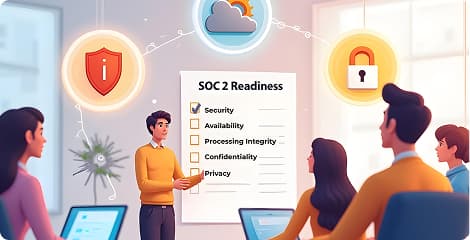Preparing for your first SOC 2 audit can feel overwhelming, but with a clear plan, you can approach it strategically and confidently. Many SaaS founders and security leaders hesitate due to the perceived complexity, cost, and time commitment. This post will help you understand how to prepare for SOC 2 audit by breaking down the steps involved and addressing common concerns. By following this roadmap, you’ll not only streamline your compliance efforts but also turn SOC 2 into a powerful growth enabler.
Let’s dive into the preparation journey step by step.
Why SOC 2 Matters for SaaS Startups?
For SaaS startups, learning how to prepare for SOC 2 audit is essential to building trust and accelerating sales. SOC 2 certification signals to customers and investors that you handle data securely and meet industry-recognized criteria such as security, availability, and confidentiality—the Trust Services Criteria (TSC). Enterprises now expect rigorous proof of compliance, making SOC 2 a key to unlocking large contracts and funding rounds. Carefully preparing helps you address these expectations effectively while positioning your startup as a responsible and reliable partner.
SOC 2 Prep: A 6-Phase Roadmap
Before diving into remediations or policy creation, the crucial first step is gaining a clear understanding of your current state. A comprehensive internal assessment and gap analysis form the foundation of your SOC 2 readiness. This early evaluation helps identify which business processes and controls align with the Trust Services Criteria (TSC) and pinpoints where your organization may be falling short. With this clarity, you can prioritize remediation efforts and build a realistic, efficient roadmap for compliance.
Phase 1: Internal Assessment & Gap Analysis
The first step to successfully prepare for SOC 2 audit is conducting an internal assessment. Map your business processes and system infrastructure to the Trust Services Criteria. Analyze current risks and identify gaps where your controls or policies don’t meet SOC 2 requirements. This gap analysis helps prioritize remediation efforts and provides clarity on your compliance posture before deeper preparation.
Phase 2: Building Policies & Controls
A fundamental part of how you prepare for SOC 2 audit is developing comprehensive policies and controls. Focus on access management, change controls, incident response, and confidentiality protocols. Use industry-standard templates or expert help to ensure policies are aligned with your SaaS operations. Embed these controls in daily workflows and ensure all team members understand their responsibilities. Strong documentation and enforcement are what auditors expect.
Phase 3: Choosing the Right Tools
To ease efforts and maintain ongoing compliance, SaaS companies need to utilize the right tools while they prepare for SOC 2 audit. Automation solutions for ticketing, asset management, audit logging, and monitoring can streamline evidence collection. Platforms like Vanta or Drata offer specialized automation for SOC 2, but customized in-house tools can also work well, especially when integrated into DevSecOps pipelines.
Phase 4: Evidence Collection & Documentation
A critical phase in how to prepare for SOC 2 audit is gathering and organizing evidence. Evidence includes logs, access reviews, change tickets, training records, and incident reports. Automate wherever possible to reduce manual tracking errors and ensure consistent documentation during the audit period. Well-maintained evidence repositories save time and reduce auditor friction.
Phase 5: Working with a Trusted Auditor
Once you understand how to prepare for SOC 2 audit, selecting the right auditor is vital. Seek auditors familiar with SaaS compliance challenges and your industry. Many offer pre-audit readiness checks that pinpoint weaknesses and suggest fixes before the formal audit. A strong partnership with your auditor means smoother communication and fewer surprises, ensuring the audit day goes as seamlessly as possible.
Phase 6: Ongoing Monitoring & Future Proofing
SOC 2 compliance requires ongoing effort. To prolong success after you prepare for SOC 2 audit, implement continuous monitoring and plan for annual reassessments. Moving from Type 1 (a snapshot audit) to Type 2 (testing controls over time) shows maturity to bigger clients. Embed compliance into your operational habits to reduce risk and maintain trust over the long run.
Common Mistakes to Avoid While Your Prepare For SOC 2 Audit
Delaying your SOC 2 preparation until the last minute can severely jeopardize your timeline and budget. Rushing through the process often leads to incomplete controls, missed documentation, and unnecessary stress. Start early to build a steady, manageable workflow.
Neglecting evidence tracking is another major pitfall. Without organized and consistent documentation of controls—such as access logs, change management tickets, and training records—audits become frustrating and prolonged. Implement automated tools and define clear processes to capture this evidence in real time.
Unclear ownership of compliance roles slows progress and accountability. If no one is specifically responsible for managing controls, coordinating audits, and maintaining documentation, gaps form and issues remain unresolved. Assign a dedicated compliance lead or build a cross-functional team with clear responsibilities.
Overreliance on manual processes without automation leads to fatigue, errors, and inconsistencies. Automating repetitive tasks like evidence collection, monitoring, and reporting reduces human error and frees your team to focus on remediation and improvements.
Additionally, avoid poor scoping of your SOC 2 audit by clearly defining which systems and services are in scope. This prevents costly surprises and ensures auditors focus on relevant controls.
Finally, failing to perform a readiness assessment before the audit can leave critical gaps undiscovered. Use this “trial run” to fix issues early and align expectations with auditors.
How Invimatic Can Help
Invimatic’s expertise helps SaaS companies prepare for SOC 2 audit more efficiently. Our DevSecOps and QA Automation tools automate control enforcement and evidence gathering, reducing manual work. The Fractional CISO service offers tailored security leadership to guide your team through complex requirements while managing costs. Our Product Engineering services align development processes with compliance needs, ensuring SOC 2 readiness is baked into development workflows. With Invimatic’s support, your SOC 2 preparation journey becomes smoother and scalable.
The Bottom Line
Knowing how to prepare for SOC 2 audit is critical for SaaS startups targeting enterprise clients and funding milestones. By following a structured roadmap, from internal assessment to ongoing monitoring, you build a compliance program that’s manageable and strategic. Early planning avoids surprises and positions your company as trustworthy and growth-ready. Start your SOC 2 journey now: download our SOC 2 Preparation Checklist, get a free readiness assessment, or schedule a 30-minute SOC 2 strategy call. Preparation is your strongest asset, make it count.






Your email address will not be published. Required fields are marked *